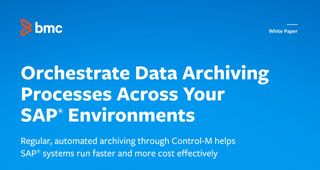Remember when we used to talk about big data? Volume, variety, veracity, and velocity—the metrics were mind boggling. Today we are actually living in that reality. Businesses are generating, collecting, and trying to manage and analyze more data than we ever thought possible. Sales data, check. Market data, check. Internet of Things (IoT) data, systems of record, social media data…check, check, check.
Data is everywhere, and it’s only growing (in size and importance). So much, in fact, that the term “big data” is basically dead. Now it’s just data. Every company is focused on turning all this data into insights. And that’s great; it’s pushing the boundaries of what’s possible. But what do you do when all that data starts aging? Many companies are struggling because they still haven’t developed effective data archiving strategies.
This can be especially true for companies with large SAP® installations. Why? Because, over time, SAP implementations generate tons of data. Often, the data is sitting on production instances, slowing jobs and process and development cycles. Explosive data growth in SAP systems causes deterioration of application performance and user productivity, and it generates higher costs due to large tier-1 enterprise storage volumes (with redundancies) and higher administration costs due to long backup/maintenance windows and SAP upgrades.
So, why don’t companies just archive all this data? The simple answer: because it’s not that easy. Here are a few common challenges:
- Consensus: Stakeholders across the organization often can’t agree on retention policies. Data archiving affects many groups, including IT operations (ITOps), business users, functional and technical SAP teams, and legal and compliance teams, etc.
- Rules and regulations: There are a lot of rules to consider, including audit guidelines, industry-specific Food and Drug Administration (FDA) regulations and many more.
- Future availability: And we can’t forget the fear factor. Everyone asks, “What happens when we need this data and it’s no longer available?”
SAP recommends that companies archive data regularly. But it’s critical to take a comprehensive, automated approach. Built-in and home-grown archiving tools are often limited in scope. For example, SAP includes some of its Information Lifecycle Management (ILM) functionality in its standard NetWeaver technology platform, but a separate ILM license must be purchased to use it for other types of data.
Meanwhile, enterprises already have solutions in place for archiving and file transfers for their non-SAP data, so the separate ILM license could be considered a redundant cost. Many legacy solutions have similar limitations on the data types they can handle and the applications, storage, and other infrastructure components they can work with, which has made multi-tool environments common.
Beyond that, the impending SAP ERP Central Component (ECC) end-of-life and SAP S/4HANA® becoming the favored form of SAP demands a modern approach to data archiving. Fortunately, Control-M can help. Control-M is an SAP-certified solution that creates and manages SAP ECC, SAP S/4HANA, and SAP Business Warehouse and data archiving jobs, and can support any application in the SAP ecosystem. This eliminates time, complexity, and the requirement for specialized knowledge. It can also be used for all other enterprise jobs, services, processes, and workflows. That lets organizations using SAP build, orchestrate, run, and manage all their enterprise jobs from a consolidated, integrated platform that provides visibility across all enterprise workflows and their dependencies. The result?
- SAP system performance and response times improve, which reduces hardware and administrative costs.
- System availability increases, resulting in less downtime during release upgrades.
- Employees across the organization get better access to data and documents.
- Archived data will be compressed and stored in archive files (accessible through application reports or through an archive information system like SAP Archive Information System).
- Companies will be better positioned against security threats and for audit/compliance requirements.
- Data archiving will help organizations accelerate their journey to SAP S/4HANA.
Want to learn more about how Control-M can help your organization streamline data archiving processes? Check out this white paper.
SAP, SAP S/4HANA are the trademark(s) or registered trademark(s) of SAP SE or its affiliates in Germany and in several other countries.
Orchestrate Data Archiving Processes Across Your SAP® Environments
These postings are my own and do not necessarily represent BMC's position, strategies, or opinion.
See an error or have a suggestion? Please let us know by emailing blogs@bmc.com.





